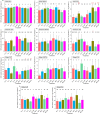Mild chronic exposure to pesticides alters physiological markers of honey bee health without perturbing the core gut microbiota
- PMID: 35277551
- PMCID: PMC8917129
- DOI: 10.1038/s41598-022-08009-2
Mild chronic exposure to pesticides alters physiological markers of honey bee health without perturbing the core gut microbiota
Abstract
Recent studies highlighted that exposure to glyphosate can affect specific members of the core gut microbiota of honey bee workers. However, in this study, bees were exposed to relatively high glyphosate concentrations. Here, we chronically exposed newly emerged honey bees to imidacloprid, glyphosate and difenoconazole, individually and in a ternary mixture, at an environmental concentration of 0.1 µg/L. We studied the effects of these exposures on the establishment of the gut microbiota, the physiological status, the longevity, and food consumption of the host. The core bacterial species were not affected by the exposure to the three pesticides. Negative effects were observed but they were restricted to few transient non-core bacterial species. However, in the absence of the core microbiota, the pesticides induced physiological disruption by directly altering the detoxification system, the antioxidant defenses, and the metabolism of the host. Our study indicates that even mild exposure to pesticides can directly alter the physiological homeostasis of newly emerged honey bees and particularly if the individuals exhibit a dysbiosis (i.e. mostly lack the core microbiota). This highlights the importance of an early establishment of a healthy gut bacterial community to strengthen the natural defenses of the honey bee against xenobiotic stressors.
© 2022. The Author(s).
Conflict of interest statement
The authors declare no competing interests.
Figures



Similar articles
-
Oral or Topical Exposure to Glyphosate in Herbicide Formulation Impacts the Gut Microbiota and Survival Rates of Honey Bees.Appl Environ Microbiol. 2020 Sep 1;86(18):e01150-20. doi: 10.1128/AEM.01150-20. Print 2020 Sep 1. Appl Environ Microbiol. 2020. PMID: 32651208 Free PMC article.
-
Impact of Glyphosate on the Honey Bee Gut Microbiota: Effects of Intensity, Duration, and Timing of Exposure.mSystems. 2020 Jul 28;5(4):e00268-20. doi: 10.1128/mSystems.00268-20. mSystems. 2020. PMID: 32723788 Free PMC article.
-
Imidacloprid Decreases Honey Bee Survival Rates but Does Not Affect the Gut Microbiome.Appl Environ Microbiol. 2018 Jun 18;84(13):e00545-18. doi: 10.1128/AEM.00545-18. Print 2018 Jul 1. Appl Environ Microbiol. 2018. PMID: 29678920 Free PMC article.
-
Honey bees as models for gut microbiota research.Lab Anim (NY). 2018 Nov;47(11):317-325. doi: 10.1038/s41684-018-0173-x. Epub 2018 Oct 23. Lab Anim (NY). 2018. PMID: 30353179 Free PMC article. Review.
-
Structural diversity and functional variability of gut microbial communities associated with honey bees.Microb Pathog. 2020 Jan;138:103793. doi: 10.1016/j.micpath.2019.103793. Epub 2019 Oct 15. Microb Pathog. 2020. PMID: 31626917 Review.
Cited by
-
Binding and Detoxification of Insecticides by Potentially Probiotic Lactic Acid Bacteria Isolated from Honeybee (Apis mellifera L.) Environment-An In Vitro Study.Cells. 2022 Nov 23;11(23):3743. doi: 10.3390/cells11233743. Cells. 2022. PMID: 36496999 Free PMC article.
-
The effects of glyphosate, pure or in herbicide formulation, on bumble bees and their gut microbial communities.Sci Total Environ. 2023 May 10;872:162102. doi: 10.1016/j.scitotenv.2023.162102. Epub 2023 Feb 9. Sci Total Environ. 2023. PMID: 36764553 Free PMC article.
-
Glyphosate-Based Herbicides and Their Potential Impact on the Microbiota of Social Bees.Toxics. 2025 Jun 29;13(7):551. doi: 10.3390/toxics13070551. Toxics. 2025. PMID: 40710996 Free PMC article. Review.
-
Evaluating the Impact of Commonly Used Pesticides on Honeybees (Apis mellifera) in North Gonder of Amhara Region, Ethiopia.J Toxicol. 2023 Mar 30;2023:2634158. doi: 10.1155/2023/2634158. eCollection 2023. J Toxicol. 2023. PMID: 37034150 Free PMC article.
-
Changes in the Activities of Antioxidant Enzymes in the Fat Body and Hemolymph of Apis mellifera L. Due to Pollen Monodiets.Antioxidants (Basel). 2025 Jan 9;14(1):69. doi: 10.3390/antiox14010069. Antioxidants (Basel). 2025. PMID: 39857403 Free PMC article.
References
-
- European Commission. Report from the commission to the European Parliament and the council on the implementation of the measures concerning the apiculture sector of Regulation (EU) No 1308/2013 of the European Parliament and of the Council establishing a common organisation of the markets in agricultural products. p. 1–16. https://eur-lex.europa.eu/legal-content/en/ALL/?uri=CELEX:52016DC0776 (2016).
-
- Ollerton J. Pollinator diversity: Distribution, ecological function, and conservation. Annu. Rev. Ecol. Evol. Syst. 2017;48:353–376. doi: 10.1146/annurev-ecolsys-110316-022919. - DOI
Publication types
MeSH terms
Substances
LinkOut - more resources
Full Text Sources
Medical

